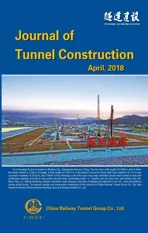Construction Technologies for Tunnels in Special and Complicated Geology of Lanzhou-Chongqing Railway
2018-04-19LINingLIGuoliang
LI Ning, LI Guoliang
(China Railway First Survey and Design Institute Group Co., Ltd., Xi′an 710043, Shaanxi, China)
0 Introduction
Lanzhou-Chongqing Railway is a major railway that represents the centenary dream of Chinese and connects the Southwest China and Northwest China. It is located in the northeast margin of the Tibetan Plateau, where the geological environment is very complicated under the impact of plate activities and compression. Transformed by the very-low-grade metamorphism and strong deformation of multiple periods and affected by faults, tectonic structures, and geostress fields, etc., large deformed soft rock and quick sand were formed. The geology was evaluated as "a global challenge that is infrequent both in China and abroad". As a result, both the design and construction of this railway were special. The current codes and standards were inapplicable and there was no precedent. A special design became the critical factor that determined the success of Lanzhou-Chongqing Railway[1]. In addition, the full-face hard-rock tunnel boring machines (TBMs) used for West Qinling Tunnel of Lanzhou-Chongqing Railway were the railway TMB with the largest diameter in China. Compared with other TBMs, they had much larger diameter and longer tunneling distance. Their adaptability requirement was more stringent, and the related supporting technology determined the TBM tunneling speed.
In the process of continuous development of construction of transport facilities in China, we have to face more and more long, large, deep, and difficult tunnel projects and more and more geological hazards and complicated geological conditions. The construction difficulty is ever growing. By taking tunnels on Lanzhou-Chongqing Railway in complicated geology as examples, the technological problems and construction technologies related to the Tertiary aquiferous quick sand, large deformation of soft rock, as well as safe, fast and long-distance tunneling by large-diameter TBMs are elaborated so as to provide reference and guide for the design and construction of tunnels in the future.
1 Project overview
1.1 Tunnel overview
With a design speed of 200 km/h, Lanzhou-Chongqing Railway, a class-I electrified double-track railway, is an important part of Chongqing-Xinjiang-Europe-Interna tional Railway under Belt and Road Initiative and the most convenient passage that connects the Southwest China and Northwest China. The 492 km-long Lanzhou-Guangyuan Section has 66 tunnels with a total length of 343 km, including 9 over-10 km-long tunnels. Among the tunnels, West Qinling Tunnel with a length of 28.236 km is the longest tunnel and the critical works of Lanzhou-Chongqing Railway Project. It is also the second longest railway tunnel completed in China and the railway tunnel constructed by TBMs with the largest diameter (10.23 m) in China.
The construction of Lanzhou-Guangyuan Section of the railway was commenced in 2008, and the section of the railway was put into operation in September 2017. It shortens the Lanzhou-Chongqing transport distance from 1 466 km to 855 km and the passenger train traveling time from 22 hours to 6.5 hours.
1.2 Geological background
Lanzhou-Chongqing Railway is located in the junction zone of the Qinghai-Tibet Plate, Yangtze Plate, North China Plate, etc. (see Fig. 1) with very special and complicated geological background. Especially, the collision between Eurasian Plate and Indian Plate, in addition to the uplift and northeastward compression and extension of Qinghai-Tibet Plate, leads to the high and variable initial geostress and developed folds and fractures in the railway site.
Fig. 1 Regional geological background of Lanzhou-Chongqing Railway
1.2.1 Special geological structures
Lanzhou-Guangyuan Section is located in the margin of Tibetan Plateau, where the geological activities are frequent. Under the impact of the geological activities in multiple periods, the geological environment becomes complicated and the regional structures develop very well. Along the line, there are 10 regional major fractures, 87 relatively major faults, 43 folds and developed secondary faults, minor structures and folds.
1.2.2 Complicated and variable geostress fields
Affected by the uplift of Tibetan Plateau and compression between plates, the geostress fields of Lanzhou-Guangyuan Section are very complicated and variable. The maximum measured geostress of Lanzhou-Minxian Section in north-east direction is 27.16 MPa and that of Minxian-Guangyuan Section in north-west direction is 33.82 MPa (see Fig. 2). The surrounding rocks of the tunnels in several places are under very high geostress.

Fig. 2 Distribution of geostress direction along Lanzhou-Chongqing Railway
2 Key points and difficulties
Tertiary aquiferous silty fine sandstone and high geostress soft rock encountered during the construction of Lanzhou-Chongqing Railway are infrequent both in China and abroad, and they are special and complicated environment. The current codes and standards are inapplicable and a special design is required. Meanwhile, how to make the large-diameter TBMs operate safely, fast and efficiently through a long distance is another task.
2.1 Tertiary aquiferous silty fine sandstone
The Tertiary clayey aquiferous silty fine sandstone with weak cementation is evaluated as "unfavorable rock" by experts. The rock has poor diagenesis. It is the transitional stratum between rock and sand, with properties of rock and sand. It is in the state of rock when undisturbed and in the state of sand when disturbed. It will quickly be softened and become pasty in contact with water. Often accompanied with water and sand gushing, cavity may be formed in the rock behind the support, which makes the support system crack or collapse and thus leads to high construction difficulty and risk (see Fig. 3). The total length of such strata is about 8 km long, located in 3 tunnels, including Humaling Tunnel and Taoshuping Tunnel.
2.2 Soft rock under high geostress
Along Lanzhou-Chongqing Railway, the total length of the soft rock under high geostress is about 83 km, located in 12 tunnels. The soft rock under high geostress is mainly composed of the Silurian phyllite and carboniferous phyllite, the Permian and Triassic slate and carboniferous slate, etc. with a low strength and soft texture. The high geostress often caused large squeezing deformation. Long cracking and intrusion of primary support and torsion and damage of steel supports happened (see Fig. 4), and in some areas, the secondary lining cracked and was damaged. It was very difficult to control the deformation, which seriously endangered the construction and operation safety. The typical tunnels include the Muzhailing Tunnel, Liangshui Tunnel, Xinchengzi Tunnel, Maoyushan Tunnel, Majiashan Tunnel, Tongzhai Tunnel, and Zhifang Tunnel, etc.
2.3 Fast long-distance tunneling by large-diameter TBMs
West Qinling Tunnel on Lanzhou-Chongqing Railway has a length of about 28.236 km and maximum overburden of about 1 400 m. Restricted by the topography, it is impossible to build access adit and so the tunnel is a deep-covered long tunnel passing through various stratum and lithology with different rock integrity and geological units. In the design, two large-diameter TBMs (see Fig. 5) were adopted for construction. There were such technological challenges as TBM adaptability, mucking mode, parallel lining, and construction ventilation of the long tunnel.

(a) Unstability of tunnel face
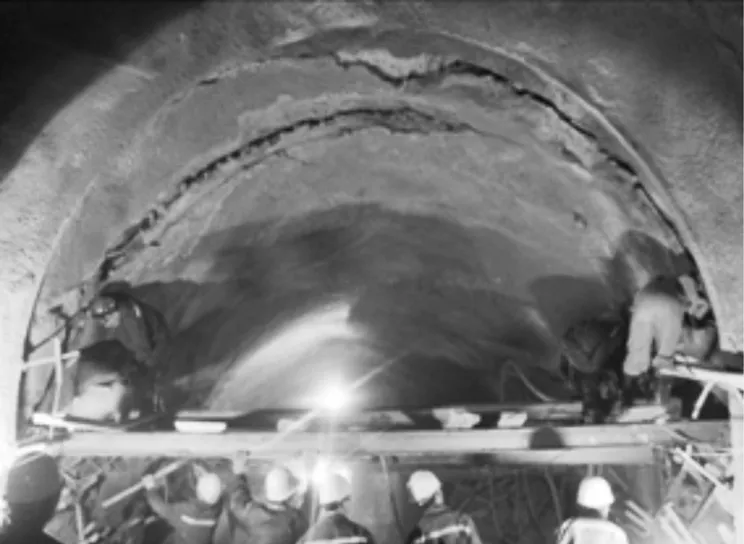
(b) Deformation and crack of primary suppnt
Fig. 3 Deteriorated and instable tertiary sandstone & deformed and damaged support
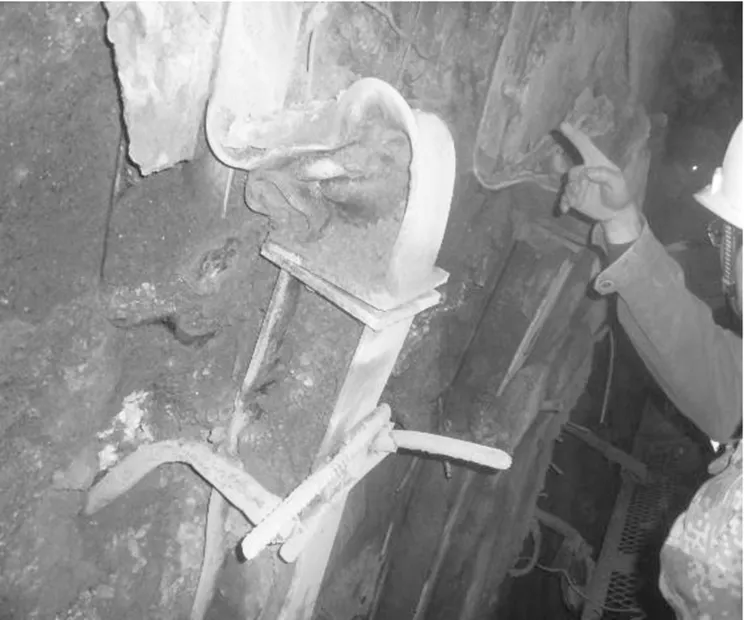
(a) Squeezing deformation of H175 shaped steel

(b) Cracking and intrusion of support

Fig. 5 TBM for West Qinling Tunnel
3 Innovation achievements
3.1 Construction technology for tunnel in Tertiary clayey aquiferous silty fine sandstone with weak cementation
3.1.1 Study of physical properties and mechanical parameters
3.1.1.1 Mechanical parameters
The physical and mechanical properties of the Tertiary aquiferous silty fine sandstone with weak cementation (Fig. 6 and 7) are ascertained to lay a theoretical foundation for the design and construction of the tunnels. The test showed that the permeability coefficient of the Tertiary aquiferous silty fine sandstone sample is similar to that of silty soil, and is much less than that of the common fine sand and even the silty sand strata. Its strength declines with the growth of its moisture content. Where the moisture content exceeds the plastic-limit moisture content, the surrounding rock becomes plastic and loses its strength[2].

Fig. 6 Grading curves of soil samples of different inclined shafts
3.1.1.2 Micro-structure variation laws
Water significantly affects its stability. Before deformation and flow, the matrix particles are granular (see Fig. 8), the pores are dominated by off-contact pores, particles contact each other at points and the structure is relatively stable; with rheological behavior, the point contact between particles disappears, small-and medium-sized particles increase sharply, various flocculent sediments settle on the pore margin, and the sand layer becomes plastic and is deformed.

Fig. 7 Permeability factors of soil samples of different inclined shafts

(a) Before flowing deformation
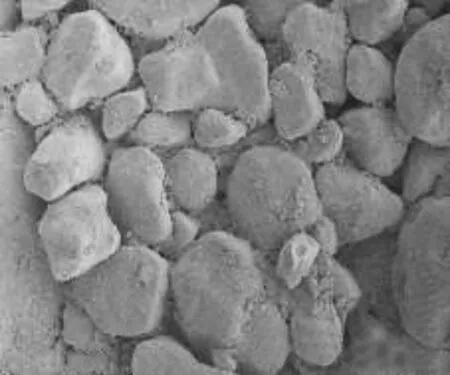
(b) After flowing deformation
3.1.2 Study of water-related stability and critical deformation rule
The water-related stability mechanism of the Tertiary aquiferous silty fine sandstone with weak cementation is ascertained (see Fig. 9): in the case of low moisture content, sandstone particles are under equilibrium load and stable state; in the case of high moisture content, the structure is damaged, and the particles may be easily plastically deformed or rheological behavior occurs. The field tests at 11 working faces showed that the moisture content of 12%-16% 3-5 h after excavation is the critical point of plastic deformation of surrounding rock and the moisture content of 18%-19% 7-10 h after excavation is the critical point of rheological behavior of surrounding rock.

Fig. 9 Variation of moisture content of sandstone before dewatering
3.1.3 Study of comprehensive dewatering technology
The strength of the sandstone obviously declines with the moisture content, which eventually leads to flowing sand. Therefore, it′s necessary to develop a reasonable dewatering technology to keep the moisture content of the sandstone below the critical moisture content so as to ensure the stability of the surrounding rock. Tests on advance dewatering and post dewatering were carried out on the site: in the case of excavation before dewatering, it took consecutive 24 h for dewatering to make the moisture content below the plastic limit (see Fig. 10), while in the case of advance dewatering, the moisture content remained around 5%, which is much lower than the critical moisture content, and the sandstone exhibited a good stability (see Fig. 11)[3].
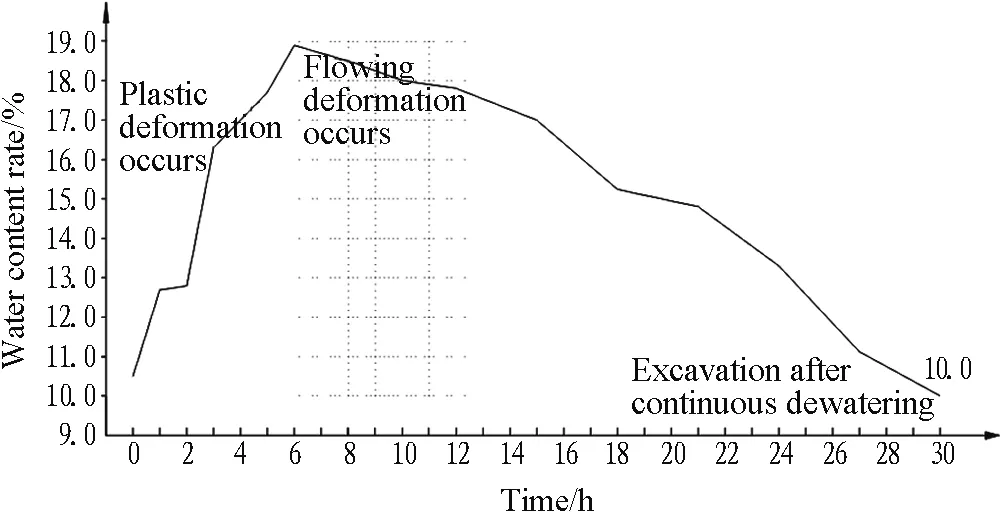
Fig. 10 Excavation before Dewatering
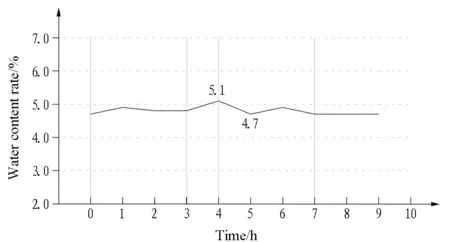
Fig. 11 Advance vacuum dewatering
A comprehensive dewatering technological system integrating deep surface wells and vacuum light well points in tunnel is built (see Fig. 12); for areas with high cohesive particle content, high moisture content and thick aquifer where it was difficult to obtain the desired effect only by dewatering in tunnel, the technology of advance dewatering by surface wells with large depth (more than 200 m) and the well forming technology were applied to the silty fine sand stratum. In this way, the effective dewatering funnel was made (see Fig. 13) to lower the water head of the Tertiary aquiferous silty fine sandstone and the moisture content of the surrounding rock. The practice proved that the surface dewatering was effective. Before surface dewatering, the monthly tunneling rate was about 6-7 m; after surface dewatering, the monthly tunneling rate was increased to 15-20 m.
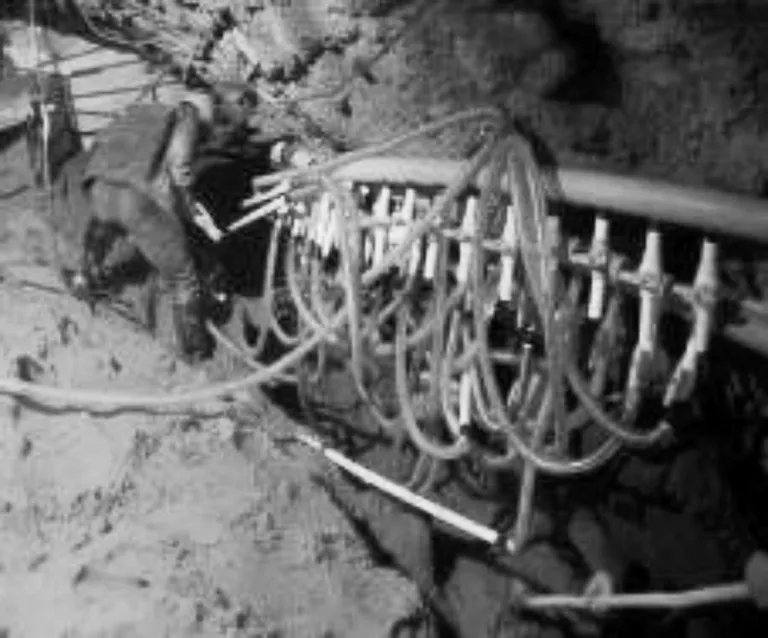
Fig. 12 Layout of light well point dewatering pipes in tunnel

Fig. 13 Surface dewatering well
3.1.4 Construction technology of advance reinforcement by full-face horizontal jet grouting piles
The construction technique of advance reinforcement by horizontal jet grouting for tunnels in aquiferous silty fine sand is developed. For the exit section of Taoshuping Tunnel, high-pressure horizontal jet grouting was applied for the excavation contour scope, and the reinforcement by fiberglass anchor bolts+horizontal jet grouting piles was applied to the working face (Fig. 14). After the reinforcement, bench excavation method can be used, which is characterized by high mechanization and fast construction.

(b) Working site
3.1.5 Study of tunnel construction technology in Tertiary aquiferous silty fine sandstone with weak cementation
3.1.5.1 Characteristics of loads of surrounding rock
The tunnel in aquiferous sandstone with weak cementation may be quickly deformed after excavation and its deformation is difficult to control. To provide theoretical support for the design and construction of the tunnel, field tests on the surrounding rock pressure, contact pressure, and concrete stress, etc. are made. The tests showed that the surrounding rock pressure of the Tertiary sandstone is saddle-shaped (Fig. 15) and characterized by high surrounding rock pressure at the spring lines on both sides and low surrounding rock pressure at the crown.
3.1.5.2 Construction method
In line with the characteristics of the pressure of the Tertiary surrounding sandstone, the supporting rigidity was enhanced in the design. The Ⅰ25 shaped steel arches were used. For areas suffering serious flowing sand and large deformation, two-layer supporting was employed; according to such parameters as the cohesive particle content, permeability factor, cohesion and frictional angle at each working area, the cross diaphragm (CRD) method and double-side heading construction method were used. Orderly construction can be obtained by using each of the construction methods. However, the double-side heading construction method is recommended for areas with high moisture content and serious liquefaction (Fig. 16). Based on the surrounding rock characteristics of working area of inclined shaft #3, the construction method combining advance dewatering in the double-side heads and CRD on the upper bench (Fig. 17) is designed.

Fig. 15 Distribution of surrounding rock pressure (unit: MPa)

Fig. 16 Nine-step double-side heading method

Fig. 17 Double-side heading construction method
3.2 Deformation control technology for tunnels with large deformation in soft rock under high geostress
3.2.1 Classification of large deformation
At present, there are many deformation classification methods for tunnels with large deformation in soft rock under high geostress. However, many factors control the large deformation[4], and it is very difficult to use one method or indicator to evaluate the deformation scale or class in advance. Common large deformations are classified according to the total deformation class of the primary support during the construction, and this is a kind of passive classification that cannot reflect the real conditions of the surrounding rock because it is significantly affected by construction. As a result, based on the previous deformation classification method for squeezing surrounding rock in combination with matching between the supporting and deformation during construction in squeezing surrounding rock, the method integrating advance evaluation and classification for deformation potentiality of squeezing surrounding rock in design and classification for dynamic adjustment in construction is developed[5].
3.2.1.1 Advance evaluation of deformation potentiality in design
In the design, according to geological conditions and previous cases of tunnel with large deformation, the advance large-deformation evaluation is carried out and the deformation potentiality classification method with the strength-stress ratio as the major indicator for soft rock tunnels with large deformation is established (see Table 1).
Table 1 Deformation potentiality classification method for soft rock tunnels with large deformation on Lanzhou-Chongqing Railway

ClassoflargedeformationStrength⁃stressratioRelativedeformation/%Ⅰ0.25-0.151.5-3Ⅱ0.15-0.13-5Ⅲ <0.1>5
3.2.1.2 Dynamic adjustment in construction
In the construction, according to surrounding rock characteristics revealed by the working face and adjacent sections, the large deformation potentiality is evaluated (see Table 2); through the real-time monitoring, the deformation process of the squeezing surrounding rock is monitored and traced and the portentous information prior to the occurrence of large deformation and the deformation rule is obtained. Then, a further evaluation on the deformation is made by using two indicators, i.e., the deformation amount and deformation rate (see Table 3). Meanwhile, the matching between the supporting and surrounding rock is evaluated according to the supporting damage conditions (see Table 3) and the supporting parameters are adjusted and optimized accordingly to realize dynamic design and adjustment[6].

Table 3 validation criteria for large deformation classification of soft rock tunnels of Lanzhou-Chongqing Railway
Remarks: Crown settlement can be considered as per 50% of the horizontal convergence.
3.2.2 Technical countermeasures
3.2.2.1 Testing in advance
According to the principle of "testing in advance for special and complicated works", the tests are made to validate the supporting parameters and section types corresponding to the deformation potentiality classification established in the design, the deformation and supporting loads are monitored, and the parameters and deformation control measures are duly adjusted according to the test results. The displacement in front of the working face in railway tunnels is measured for the first time (see Fig. 18) and the advance deformation rule ahead of the working face of tunnels in soft rock is mastered.
3.2.2.2 Deformation control technology
The study shows that the large deformation of Lanzhou-Chongqing Railway belongs to large structural squeezing deformation caused by energy accumulation, transfer and release under the control of structures as well as shearing and shifting of structures. Therefore, according to the genesis mechanism of large squeezing deformation, a comprehensive deformation control technology combining the active stress release and passive control is developed. It includes: (1) active energy release and consumption; (2) surrounding rock improvement and reinforcement to increase its bearing capacity and energy storage capacity; (3) improvement of resistance and adaptability to deformation of supporting system.

(a) Pipe burying

(b) Test operation
Fig. 18 Measurement of longitudinal displacement in surrounding rock of working face
(1) Active release
Based on the deformation classes, we increased the deformation allowance according to the conditions revealed by working face excavation and the actual deformation conditions. For sections with high predicated deformation class, we made large advance boring and advance pilot when necessary to facilitate active stress release (Figs. 19 and 20). For the ridge core section of Muzhailing Tunnel, to solve the problem of large deformation and repeated primary support removal/replacement, we made the advance pilot for stress release and succeeded in the construction of ridge section with large deformation, reducing the primary support removal/replacement.

Fig. 19 Stress release by large advance boring
(2) Improvement and reinforcement of surrounding rock
The short, medium and/or long anchorage/grouting system are used to improve the surrounding rock in phases and steps and enhance the bearing capacity (Fig. 21). This method was successfully used for Xinchengzi Tunnel, the first station tunnel with super-large cross-section (with an excavation cross-section area of 340 m2) in soft rock with high geostress.

Fig. 20 Stress release by advance pilot

Fig. 21 Anchorage system
(3) Improvement of resistance and deformation adaptability of supporting system
For sections with high predicated deformation class, the multi-layer supporting system was built in layers to make the supporting system yielding; the cross-section type to put the structural cross-section under reasonable loads is adjusted so as to adapt to the surrounding rock deformation. For the first time, an energy-absorption buffer structure is used in the design of tunnels in soft rock with high geostress (see Fig. 22). The buffer structure can enhance the energy-absorption capacity of the supporting system in sections where the deformation cannot be stabilized, and can prevent stress centralization so as to put the structure under even loads.
Regarding Muzhailing Tunnel on Lanzhou-Chongqing Railway, due to the huge loads undertaken by the supporting system, the secondary lining was partially broken. We duly adjusted the cross-section type (Fig. 23) and used the multi-layer supporting to protect the secondary lining from cracking. In addition, we set energy-absorption buffer between the primary support and the secondary lining. The test showed that the loads borne by the supporting structure of sections provided with an energy-absorption buffer are even and are 40% lower than those of sections without the energy-absorption buffer. The energy-absorption buffer mitigates the risk of secondary lining cracking in the later stages.

Fig. 22 Buffer structure

Fig. 23 Circular cross-section of multi-layer supporting
3.2.2.3 Operation monitoring
Tunnels in soft rock with high geostress can only be finally stabilized by 2-3 years or even 5-6 years after the completion of the construction. Moreover, lining cracking and damage often occur during operation, which endangers train operation safety. To ensure the safety of the tunnels in soft rock with high geostress on Lanzhou-Chongqing Railway during operation, a long-term monitoring system, including real-time monitoring and automatic data transmission, is employed for tunnels in soft rock with high geostress for the first time in China. In addition, in order to ensure the safety, the monitoring management criteria for the operation of tunnels in high geostress soft rock is put forward, with considerations of operation, repair and maintenance.
3.3 Long-distance safe and fast tunneling technology of large-diameter TBM
3.3.1 Study of TBM adaptability
By using advanced technologies such as the remote sensing technology, controlled-source audio-frequency magnetotellurics (CSAMT) V8 geophysical prospecting survey line and deep drilling, comprehensive geological investigation is carried out and the geological structure, strata lithology, surrounding rock characteristics, geostress, and groundwater, etc. of the tunnel area are ascertained and the tunnel scheme with the best geological conditions is selected. The tunnel is mainly located in the lower Proterozoic phyllite and metamorphic sandstone, as well as limestone at local positions. The structure zones include 5 fracture zones and 5 fold cores. According to the geotechnical indicators and the fracture zone distribution, the construction scheme of using two large-diameter TBMs at the exist section is doveloped[7].
The result shows that the design and type selection of the TBMs for West Qinling Tunnel are successful. World records including the daily boring rate of 42 m, weekly boring rate of 235 m, and monthly boring rate of 843 m of large-diameter TBMs, as well as the new record of the longest boring length of 15.6 km by large-diameter TBMs, were created.
3.3.2 Study of parameters of long-distance-boring TBM
3.3.2.1 Reasonable design of cutterhead and cutting tool spacing
To enable the TBMs of West Qinling Tunnel to continuously operate through a distance of 15.6 km, according to such geological parameters as the rock uniaxial compressive strength and integrity factor, the energy transfer rule in the process of rock breaking by disc cutter is analyzed from the view of rock breaking capacity, the boring performance indicators based on the analysis of the cutterhead input energy and the rock mass output energy is determined, and the TBM cutterhead and reasonable cutting tool spacing for West Qinling Tunnel is designed[8].
3.3.2.2 Design of driving system and main bearing fatigue damage
Based on the study of the dynamic characteristics of the driving system, the problems including the driving system and the main bearing fatigue damage are analyzed, and the design principle for the driving system resistance against fatigue damage under the precondition of meeting the power requirement is put forward, and the principle for key parameter selection that can guide the design of main bearing resistance against fatigue damage is established.
3.3.3 Technology of boring and parallel lining
Previously, the construction of tunnels by TBMs follows the procedure of "Tunneling through by TBM-TBM removal-Lining". The required long construction duration and the lining seriously lagged, which lead to the risk of supporting deformation and instability. To mitigate the risk and shorten the construction duration, the jumbo and platform that allow passage of the locomotives, cables, air pipe, and belt conveyor is designed (see Fig. 24) to achieve uninterrupted mucking by continuous belt conveyors during the secondary lining construction. The concrete ever-standing pipe working system is developed to prevent the concrete pipeline from interfering with the passage of the locomotives during concrete placing. The telescopic platform between the jumbo and platform is set to replace the belt conveyor support, realizing the parallel operation of TBM boring, locomotive passage and lining under the condition of mucking by continuous belt conveyors for the first time[9]and thus shortening the construction duration by 20 months.

Fig. 24 Technology of TBM boring accompanied by lining construction (unit: cm)
3.3.4 Mucking by continuous belt conveyor system
To meet the demand of large cross-section fast tunneling by large-diameter TBMs and solve the problems of complicated topography of West Qinling Tunnel, large mucking amount, large transport amount of materials, and timely transfer of spoil materials, on the basis of advanced construction technologies and ideas, the multi-stage belt conveyor mucking system[10]is developed and one-stop transport from the TBM working face to spoil yard outside the tunnel is achieved (Fig. 25). Such a transport mode exhibited advantages of safety, high efficiency, environmental friendliness, and energy saving, and made significant contribution to safe and fast construction of the tunnel.

(a) Inside tunnel

(b) Outside tunnel
The quick non-damage belt contracting and extending equipment is developed to allow the long-distance belt to perform two functions, i.e., automatic contracting and extending and transport in the tunnel and make the continuous belt be conveniently extended; to prevent breakdown of the whole system caused by the fault of the single-stage belt, a belt serial redundant system is developed to improve the fault-tolerant capability of the belt system and ensure continuous and fast tunneling of TBMs. In addition, the hydraulic shifting plate for spoil distributor is developed to achieve continuous spoiling loading of multiple trucks and seamless linkage between the belt conveyor mucking system and the spoil trucks.
3.4 Super-long-distance ventilation
The longest TBM construction ventilation distance of West Qinling Tunnel is 20 km, while that of previous similar tunnel works is about 13 km. How to solve problems of out-of-limit hazardous gas, dust and temperature in the tunnel was a great challenge for tunnel construction ventilation. Based on the access adit, a two-stage ventilation mode is invented: the dead-end blowing ventilation is used in phase Ⅰ while the combined gallery ventilation on the basis of the fresh air supply from phase Ⅰ and dirty air venting by inclined shafts was used in phase Ⅱ (see Fig. 26). Moreover, comprehensive energy saving measures such as using the high-power energy-saving variable-frequency fans, large-diameter high-pressure flexible ventilation ducts and anti-leakage high-strength joints are taken for the first time in super-long-distance construction of TBMs to meet the tunnel ventilation standard, and thus a new economical and environmental friendly mode for construction ventilation of similar works in the future is created.
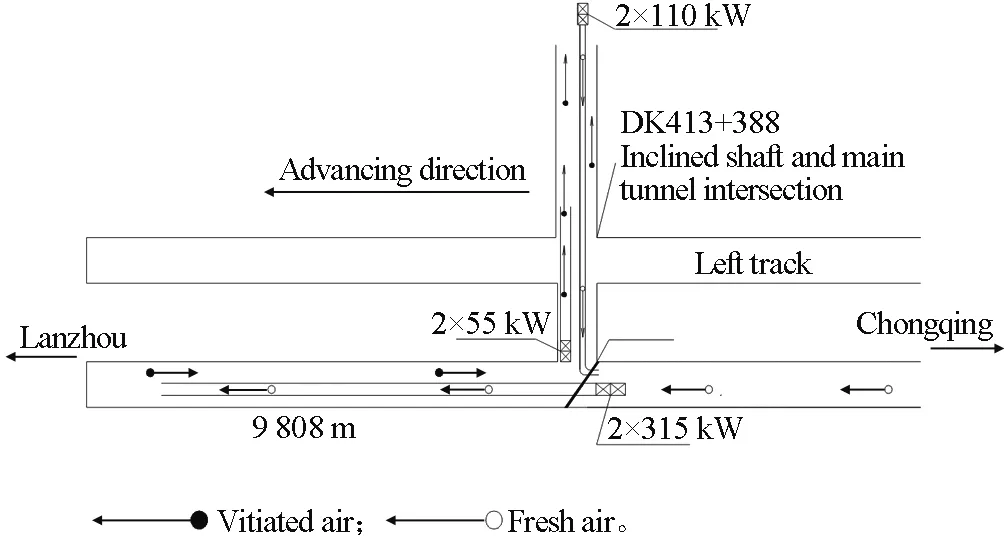
Fig. 26 Combined gallery ventilation in phase Ⅱ
Test data showed that the test result was closely related to the operation status of fans. Except the high dust concentration and noise at the startup of the fans, other indicators were lower than the standard values. In other time, all the indicators were lower than the control standard values. Both the ventilation effect and dirty air venting time can meet construction requirements.
4 Conclusions and experience
Based on the scientific tests, practices and adjustments made by all the parties participating in the construction, innovation and exploration in various fields of the technologies of construction in special and complicated geology were carried out and the global challenge of the Tertiary quick sand was overcome, the large deformation of high geostress soft rock was controlled, the technical problem of safe, fast and long-distance construction by large-diameter TBMs was solved, and finally a complete set of feasible and effective design and construction technologies was developed. The conclusions and suggestions are as follows:
(1) With a critical moisture content for plastic deformation of 12%-16% and that for rheological behavior of 18%-19%, the Tertiary sandstone has very poor water-related stability. The comprehensive dewatering technology integrating deep surface wells and light well points in tunnel can make the moisture content below the critical value and thus can ensure the stability of the sandstone. In addition, the construction technique featured with advance reinforcement by horizontal jet grouting for the full face of tunnels in aquiferous silty fine sand strata was developed, and the construction technique is environmental friendly and effective. It is suggested to use specialized teams to carry out construction of key operations such as dewatering and advance horizontal jet grouting.
(2) The principle of dynamic design and making test first should be applied to tunnels with large deformation in soft rock with high geostress. It is advisable to do pre-design of classification according to the strength-stress ratio of surrounding rock, carry out dynamic adjustment during construction according to the surrounding rock characteristics, deformation amount, deformation rate, and supporting damage types, etc., and use the comprehensive deformation control technology combining active stress release and passive control. However, in view of the complexity and specificity of tunnels in soft rock with high geostress, it is necessary to carry out further studies on the deformation mechanism and classify the deformation potentiality in various ways so as to improve the accuracy of pre-evaluation.
(3) In the design and construction of the tunnel bored by TBMs, attention should be paid to the adaptability to the surrounding rock. The advanced and effective technologies such as the parallel lining during operation of belt conveyors and the belt conveyor mucking system were developed and a complete set of technical system for safe, fast and effective tunneling by TBMs was established. According to the characteristics of long-distance tunneling by large-diameter TBMs, further studies should be carried out on parameter design and fatigue resistance of TBM cutterheads and cutters, the correlation between the geology and tunneling parameters should be analyzed in detail, and TBM tunneling record should be established to improve the TBM tunneling efficiency.
5 Honors achieved by the project
(1) Scientific and technological achievements: 1 special prize, 1 first prize, 2 second prizes of science & technology progress award at the level of province and ministry; 1 normalized construction technique at the state level and 3 normalized construction techniques at the level of province and ministry;
(2) Patents: about 50 invention patents and utility model patents have been granted.
6 Organizations participating in the project
Designer: China Railway First Survey and Design Institute Group Co., Ltd.
Construction contractors: China Railway Tunnel Group Co., Ltd., China Railway 11 Bureau Group Co., Ltd., China Railway 18 Bureau Group Co., Ltd., China Railway 19 Bureau Group Co., Ltd. and China Railway 21 Bureau Group Co., Ltd.
Scientific research organizations: Beijing Jiaotong University, Shijiazhuang Tiedao University, Southwest Jiaotong University, Lanzhou Jiaotong University and China Railway Southwest Research Institute Co., Ltd.
Acknowledgement
The study was supported by the Study of Comprehensive Safe Construction Technologies for Super-long Tunnels in Complex Geology (2009G009-B).
:
[1]LI Guoliang.Construction difficulties and countermeasures for the Lanzhou-Chongqing railway tunnels in complicated geological conditions[J]. Modern Tunnelling Technology, 2015, 52(5): 10.
[2] China Railway First Survey and Design Institute Group Co., Ltd., and Beijing Jiaotong University. Experimental study of physico-mechanical parameters of water-containing poorly-cemented sandstone formation[R]. Xi′an: China Railway First Survey and Design Institute Group Co., Ltd., 2010.
[3]LI Guoliang,WANG Fei. Major technical measures of the third series argillaceous weak cementation rich water silty sand rock tunnels[J]. Journal of Chongqing Jiaotong University (Natural Science), 2015, 34(4): 39.
[4] LI Guoliang, LI Ning. Discussion of tunnelling in squeezed surrounding rock[J]. Modern Tunnelling Technology, 2018, 55(1): 1.
[5]LI Guoliang, LIU Zhichun, ZHU Yongquan. On the large squeezing deformation law and classification criteria for the Lanzhou-Chongqing railway tunnels in soft and high geostress rocks[J]. Modern Tunnelling Technology, 2015, 52(1): 62.
[6] WANG Jianjun. The deformation mechanism of a tunnel in triassic slate and forecasting surrounding rock classifications [J]. Modern Tunnelling Technology, 2013, 50(2): 79.
[7] LI Guoliang, SI Jianjun, LI Ning. Construction scheme of the West Qinling Extra-Long Tunnel on the Lanzhou-Chongqing Railway[J]. Modern Tunnelling Technology, 2014, 51(3): 7.
[8]GUO Wei, SONG Liwei, ZHU Dianhua,et al.Matching characteristics analysis of TBM cutterhead boring parameters and disc cutter spacing based on energy principle [J]. Journal of Tianjin University(Science and Technology), 2017, 50(2): 128.
[9]XU Shuangyong, SU Rui. Synchronized lining with TBM driving in West Qinling Tunnel[J]. Modern Tunnelling Technology, 2011, 48(2): 1.
[10] XU Jinlin, XU Zan, WANG Yanbo. Key technology of mucking by continuous conveyor belt: Case study of West Qinling Extra-long Tunnel[J]. Tunnel Construction, 2011, 31(6): 678.
杂志排行
隧道建设(中英文)的其它文章
- 泥水盾构水平直管内石碴起动速度研究
- Statistics of Railway Tunnels in China as of 2017
- Key Rock Mechanics Problems and Countermeasures on Huge Diversion Tunnel of Baihetan Hydropower Station
- Study of Design and Construction Technology of Ultra-large-span Tunnel at Badaling Great Wall Station
- Innovation and Future Application of Mechanized and Intelligentized Construction Technology for High-speed Railway Tunnels: A CaseStudy of Hubei Section on Zhengzhou-Wanzhou High-speed Railway
- 水中悬浮隧道概念设计及动力分析理论与模型试验进展
